Aqueous treatment
In previous posts about the conservation treatments I am able to ‘perform’ here in the archives, I have mainly been mentioning surface cleaning and basic tear repairs. In the absence of a fully equipped conservation studio with a fume-hood and necessary chemicals on the premises, I am unable to really even consider any kind of aqueous methods of conservation should these be needed for the materials we have.
This week however, I did get to dig out my water spray as our Deputy Curator Lesley Whitworth came to me with a handful of scrunched up documents from the ICSID (International Council of Societies of Industrial Design) archive in desperate need of flattening. The documents were discovered during the holiday period in December when Lesley and our administrator Debbie Hickmott were carrying out re-organisation work on some of our collections, particularly the ICSID archive.
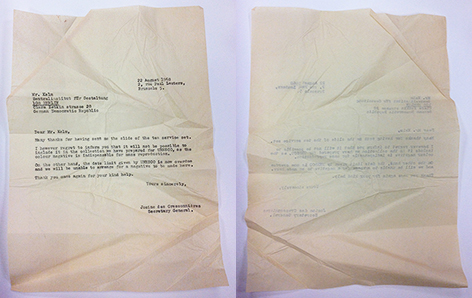
One of the documents I thought I would use as a ‘sample’ is the one in the image above, a letter dated 22 August 1968 and dictated by Josine des Cressonniéres – the Secretary General of ICSID at the time. It is a carbon copy of the original document, which is why it remains unsigned. The contents consist of a snippet of the organisation’s co-operation with UNESCO. The document was very badly creased inside an envelope with other materials in it. To have any hope of flattening it, aqueous methods needed to be adopted.
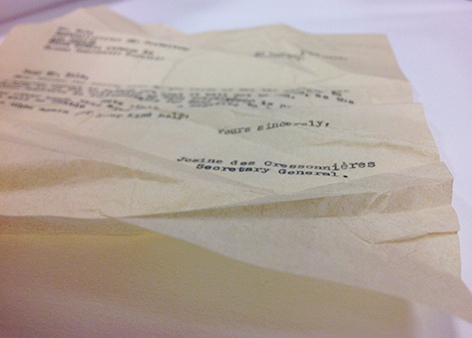
The very first thing to do when considering any kind of aqueous treatment is to test the fugitivity of all inks on the individual item. The test is carried out by a method called spot testing. This is a procedure in which a very small ‘spot’ of water is placed onto an area of the ink undergoing the testing and by adding water onto the same area until the paper fibres get more and more saturated.
During this process, keeping an eagle eye on the behaviour of the test area after each dot of water is added is of great importance – naturally no more water should be added if the ink starts to ‘run’. Placing a piece of blotter on top of the area tested is used to see if any of the inks transfer onto it marking the ink fugitive and unsuitable for aqueous methods without protection.
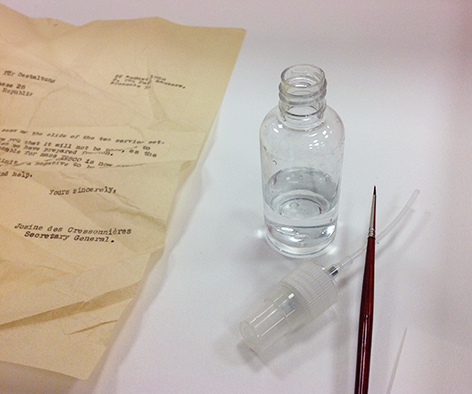
In this instance, there were no ink fugitivity problems with the copy text. I went ahead and sprayed a very fine mist of water from a distance (ie not directly onto the paper surface) and watched the document as it relaxed under the moisture. Observing paper relaxing is one of my favourite things to witness in conservation – I can almost hear the document let out a sigh of relief as the fibres go from a very tense, scrunched up state to a more relaxed, flatter state.
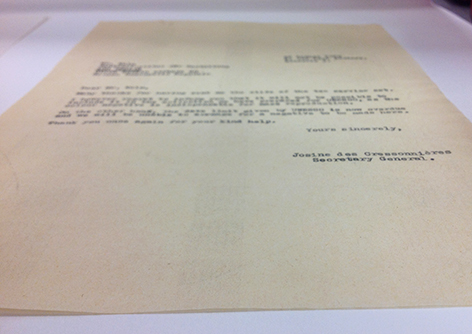
As you can see from the image above, this particular document flattened out very successfully with no problems encountered.
Another ‘sample piece’ I thought I would share with you is a photocopy of a letter dated 28th of April 1977, relating to ICSID’s Working Group on Disaster Relief. Being a photocopy, my initial thought about the originally typed text not being fugitive was right. However, this document also has an area of hand-written text in ink near the bottom right corner.

For this piece, the whole right edge was very creased from top to bottom and needed flattening to aid the safe legibility of the letter. It was stored in an envelope with other materials and had ended up folding in on itself as other papers were put in with it, like the first document.

After making sure the typed text was not going to ‘melt away’ from the paper when moistened, I spot tested the hand-written ink as I had my doubts about it being stable….

…. and stable it wasn’t! As you can see from the piece of blotter on the right in the image below, even after one drop of water, the ink became very fugitive. This of course ruled out a straight forward ‘misting’ of the piece and since I do not have access to the required materials for protecting the ink during the procedure, I put on my improvisation hat and carried on.
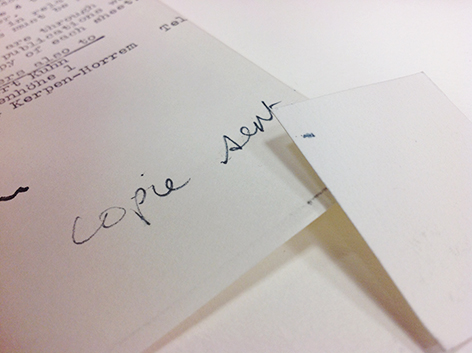
What I ended up doing to avoid the ink from running was to place that particular corner inside a Melinex ‘slip’ for protection. I then sprayed the rest of the document with a very fine mist of water to relax it. To be able to relax the corner area with the ink writing, I wetted a small piece of blotter and ‘patted’ the areas around the ink to relax the crease in the vulnerable corner. This method resulted in acceptable flattening of the entire edge of the document with no smudging of the ink when left pressed overnight.
In going back to the research materials I looked through in regards to aqueous methods within paper conservation, I dug out an article entitled “Aqueous Conservation Treatment of 20th Century Papers Containing Water-Sensitive Inks and Dyes” by Agnes Blüher, Anna Haberditzl and Tanja Wimmer in the Restaurator (Issue 20, 1999, pp181-197). The article can be found and downloaded online. Aside from the treatment methods the authors used on the materials from the archive of Heidelberg University in Germany, I picked up on a point to home in on: “there is no such thing as ‘mass conservation'”. Mass treatments can sometimes be expected of archival materials due to their nature; especially items from the 20th Century like the materials we have here at the Design Archives. To highlight that each item has to be treated on an individual basis despite being a part of a ‘bundle’ and the amount of time conservation of each document can take, I quote from the article: “… it has to be realised that the restoration needed a lot of time: 86 hours for the tape removal alone, 86 hours for the tests and the fixation, and 61 hours for the aqueous treatment and repairs. 20 hours have to be added for preparatory works, encapsulation, and documentation, so that the total time is about 250 hours for 122 sheets, that means, approximately, two hours per sheet.”
Quite a sobering thought to finish on!

Really nice blog post!
I enjoyed it very much. Thanks
Thanks very much for reading, Rita! 🙂